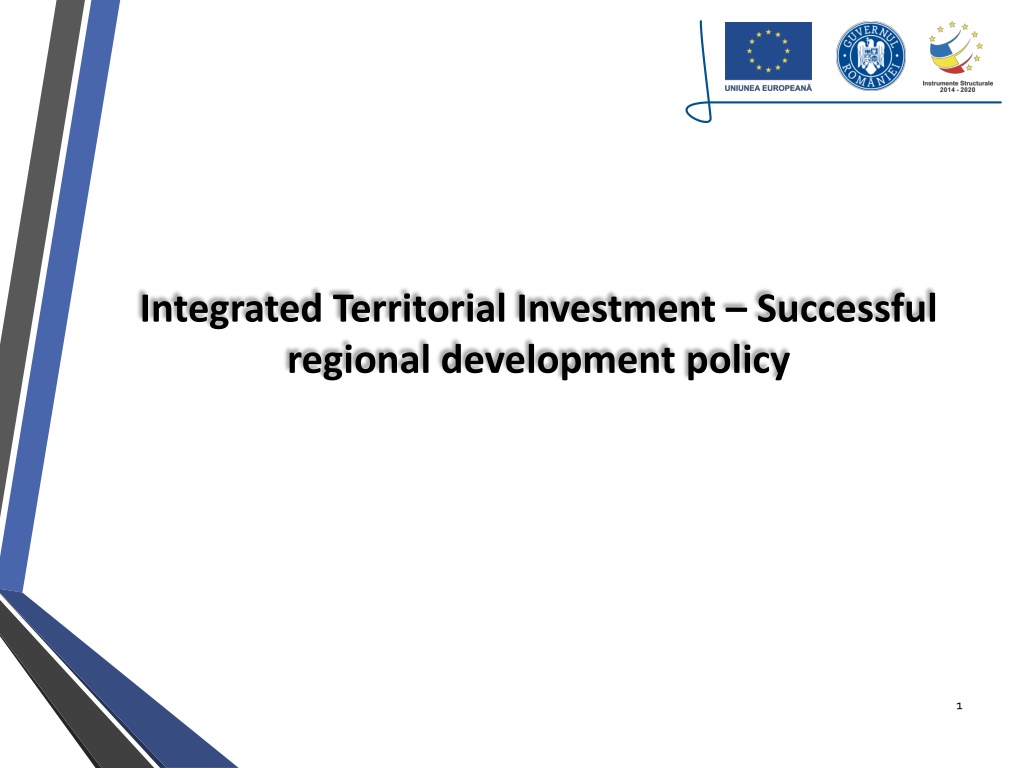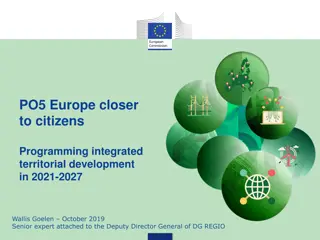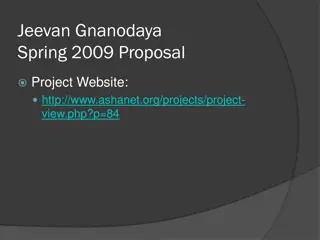
Successful Regional Development Policy Framework 2021-2027
The integrated territorial investment approach for successful regional development policy in the EU involves strategic objectives for smarter, more connected, greener, and more social Europe closer to citizens. Key aspects include investments for jobs and growth, European territorial cooperation, and different types of regions based on GDP per capita. Financial aspects, cooperation mechanisms, and the allocation of 331 billion euros for Cohesion Policy 2021-2027 are also highlighted.
Download Presentation

Please find below an Image/Link to download the presentation.
The content on the website is provided AS IS for your information and personal use only. It may not be sold, licensed, or shared on other websites without obtaining consent from the author. If you encounter any issues during the download, it is possible that the publisher has removed the file from their server.
You are allowed to download the files provided on this website for personal or commercial use, subject to the condition that they are used lawfully. All files are the property of their respective owners.
The content on the website is provided AS IS for your information and personal use only. It may not be sold, licensed, or shared on other websites without obtaining consent from the author.
E N D
Presentation Transcript
Integrated Territorial Investment Successful regional development policy 1
MAIN CHARACTERISTICS OF THE NEW FRAMEWORK FOR COHESION POLICY 2021-2027 Strategic approach- 5 objectives of the Cohesion Policy A smarter Europe A more connected Europe A greener Europe A more social Europe A Europe closer to citizens
MAIN CHARACTERISTICS OF THE NEW FRAMEWORK FOR COHESION POLICY 2021-2027 Architecture and funds Financed from ERDF, ESF+ and CF 1. Investments for jobs and growth 2. European Territorial Cooperation Financed from ERDF 3
MAIN CHARACTERISTICS OF THE NEW FRAMEWORK FOR COHESION POLICY 2021-2027 Type of Regions whose GDP per capita is less than 75% of the EU-27's average GDP 1. Less developed regions whose GDP per capita is between 75% and 100% of the EU-27 average GDP 2. Regions in transition 3. More developed regions whose GDP per capita is over 100% of the EU-27 average GDP 4
MAIN CHARACTERISTICS OF THE NEW FRAMEWORK FOR COHESION POLICY 2021-2027 Financial aspects (MFF) Main type - grants Cofinanceat national level: 70%for less developed regions and for the Cohesion Fund 40%for more developed regions. Annual prefinance 0,5 % from the total amount of support from funds It is proposed to systematize and increase the use of simplified cost options (lump sum reimbursement, standard scales for unit costs or lump sums, etc.). VAT - is not eligible for a contribution from the funds, except for operations whose total cost is less than EUR 5 000 000. Decommittment - N + 2 rule 5
Cooperation mechanism Managing auhorities Line Ministries - Lessons learned - Strategies and strategic documents - Good practice examples - Enabling conditions - Simplification - Investment needs Ministry of European Funds External support (consultants) Relevant socio-economic partners - strategic documents (PA & OPs) - Comments on strategic documents - Reports regarding enabling conditions - Investment priorities/needs -Implementation of the partnership principle (public debates)
Cohesion Policy 2021-2017 allocation The allocation of Cohesion Policy for the period 2021-2027 is 331 billion euros The current MFF allocation proposal for Romania is 30.60 billion, as follows: ESF+: 8,385 billion euro ERDF: 17,323 billion euro CF: 4,499 billion euro Proposed allocation * for each PO (excluding the amounts allocated for TA): PO1: 5,992 billion euro PO2: 5,459 billion euro PO3: 5,945 billion euro PO4: 9,673 billion euro PO5: 1,027 billion euro 7 * After reallocating 5% from the ESF to the ERDF and taking into account the thematic concentration
Integrated Territorial Investments(ITI) European funds support integrated territorial development through local and territorial development strategies implemented through ITI territorial instruments, DLRC instruments ITI - an optional tool for territorial development that makes it possible to combine the resources from several European funds, within the priority axes of one or more Operational Programs (OPs) or other nationally developed Key elements of an Integrated Territorial Investment the package of priorities and projects existence of a clearly identified territory integrated development strategy system of governance 8
Integrated Territorial Investments (ITI) - Implementation at any type of level: a region, a functional area, amunicipality,a neighborhoodor any othersub-national division the existence of a clearly identified territory - May cross administrative boundaries, because it s addressing specific requirements of an area that can improve the efficiency of publicinterventions - Increased integration of sectoral policies and interventions at the level of the identified territory - Focus on funding and prioritising interventions integrated development strategy - Thematic integration- integrating strategic objectives from several local strategies, including investment priorities from several policy objectives as well as integrating public and private fundingflows - Assumelocally theintegrated development strategy 9
Integrated Territorial Investments (ITI) Establishing priorities at the local level and successfully implementingtheprojects requires: - modifying working practices and developing the capacity to provide and implementthe territorial developmentpolicy - facilitating a strategic way of thinking - applyingtheprioritisation of theactions - concentrating resources locally package of priorities and projects system of governance 10
Challenges in implementing an ITI complexity of the instrument - Financing from several funds, including national and local possible differences between the objectives and priorities identified at national level with the needs identified at local / territorial level limited material resources at the level of the local authorities necessaryfor the preparation andimplementationof the projects low operational capacity of local actors (knowledge level, project development, budget management, team work) differences between OPs from which they are financed - complex rules in implementation limited involvement of partners the difficulty of establishing the level of financing needed for implementation - because of the funding from several funds (many funds) 11
Conclusions ITI - an optional tool for territorial development and its use should be made only in very well-founded situations, based on some Clear criteria The existence of a territory established on the basis of common specific characteristics (the same types of problems or opportunities, economic, geographical factors, etc.) Integrated Development Strategy - the main components: general objective an analysis of the development needs and the potential of the area clear investment priorities and different funding sources identified (NOT to focus strictly on funding from European funds) a list of mature investments an analysis of the impact of the proposed investments 12
Conclusions The existence of a partnership agreement elaborated and signed by all the authorities involved in ITI, which will ensure the organisation and operationalisation of the governance system. There are no separate amounts for ITI financing compared to the budget granted to RO in MFF 2021-2027 All the rules applicable to European funds also apply to ITIs, including those related to thematic focus on priority areas There is NO DEROGATION, neither in the selection, nor in the implementation, for ITI projects, compared to those applicable to the operational programs from which the financing is made !!!!! The amounts allocated unpaid will be redistributed to the OP 13
Community- Led Local Development CLLD concept European tool for promoting integrated development and community involvement in local development by forming a local partnership (Local Action Group (LAG) and implementing local development strategies (SDL) TERRITORIES on which community lead actions can be applied are: a city, small or medium, and the polarized rural area in the vicinity; a peripheral rural area devoid of urban centers; an area along a river sector or around a lake with fishing resources; a neighborhood within a city; several neighborhoods that fall into a common typology; a neighboring rural area or the peri-urban edge around a large city, or around an estuary, lake or river basin. 14
Community -Led Local Development The CLLD tool can be used in areas such as: solving problems in local labor markets solving problems regarding vulnerable social groups such as the Roma or migrant population development of economic clusters at local level creation / renovation of social shelters improving rural services small infrastructure development / rehabilitation improvement of environmental conditions. 15
Community- Led Local Development Proposal for the post-2020 CLLD approach Must be taken into consideration: the new provisions for territorial instruments at the level of post-2020 regulations - the possibility of LEAD-FUND current experience: the procedural steps taken, the framework documents elaborated the experience gained locally the large ESF allocation available to Romania (EUR 8.4 billion) and the possibility of financing the ESF under a more Social Europe only, on the one hand and, on the other hand, the need to meet the thematic concentration criteria for integrated urban development (6%) within a Europe closer to the citizens. persistence of the problems of marginalization at the city level, (but also the need for support for development, for creating a certain standard of living, for developing the business environment) 16
Community -Led Local Development It is proposed a dual use of the CLLD at the city level: Continuing the current approach, by implementing the CLLD mechanism at the level of marginalized communities in urban areas) PRIORITY Reducing the risk of poverty of vulnerable communities by implementing integrated measures through the CLLD tool - It is recommended that the ESF become Lead Fund for the dedicated LDSs of marginalized urban communities - in the conditions of orientation towards financing of the Strategies for the urban marginalized communities with priority from the ESF and their classification in OP 4 it is important to focus LDS on ESF interventions. 17
Integrated Territorial Investments The only Integrated Territorial Investment for the 2014-2020 programming period implemented in Romania, according to the Partnership Agreement, is based on the Integrated Strategy for the Sustainable Development of the Danube Delta; The strategy was elaborated by the MRDPA with assistance from the World Bank and with financial support from the POAT 2007-2013, which was approved by GD 602/2016. 1,661 Projects submitted, of which: 908 Projects contracted 826.194.326 Euro projects contracted 1.368.756.896 Euro projects submitted, of which: 1,800 1,600,000,000 1,368,756,89 6 1,661 1,600 1,400,000,000 1,400 1,200,000,000 1,200 1,000,000,000 826,194,326 908 1,000 800,000,000 800 600,000,000 600 400,000,000 400 200,000,000 200 18 0 0
Integrated Territorial Investments 1386 Approved projects, of which the allocation of ITI: 792,540,268.28 Euro 70% From the amount allocated through the ITI mechanism The territory of the ITI Danube Delta has a budget of 1.114 billion Euro, allocated by E.C. 19
Thank you! Mihaela Virginia Toader Secretary of State, Ministry of European Funds http://mfe.gov.ro/ https://www.facebook.com/MinisterulFondurilorEuropene/ https://twitter.com/mfe_romania https://www.instagram.com/mfe.gov.ro/



